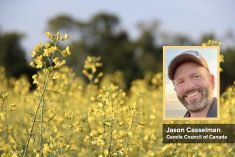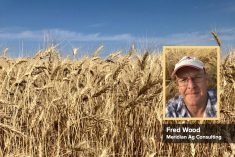New cereal varieties sometimes just can’t seem to get any respect.
While many of each season’s new canola hybrids are snapped up well before planting season, new wheats and barleys often linger on the showroom floor, hoping someone will notice them.

That’s an unfair and out-of-date attitude, says respected wheat breeder Ron DePauw, recently retired from the federal government’s Swift Current research station and now a science adviser to SeCan. He told Guide recently that over the past several decades wheat varieties have seen a host of genetic improvements, including significant productivity gains.
“Prior to about 1990, there was a genetic gain of about a third of a per cent per year for CWRS, which is the most difficult market class to breed for because of the end-use requirements,” DePauw says. “After that we saw those gains begin to grow, and fairly rapidly, until we’re now seeing annual gains that are about double that, at around two-thirds of a per cent a year.”
Read Also

Sensing the soil: Root cell research finds ‘stress hormone’
Research into how root cells react to soil stressors could help plants better adapt to changes in their climate.
DePauw says this conclusion comes from serious analysis, in this case a peer-reviewed article in the Canadian Journal of Plant Science by researchers Julian Thomas and Rob Graf, and he says there is an emerging consensus that a new concentration on research in these areas has begun to pay serious dividends to growers.
So what changed? In a word, money — and specifically money from producers.
“This can be attributed to the increase in funding,” DePauw says. “More funding first increases the number of potential varieties we can screen, and in that way it’s a straight numbers game, but then those numbers have to be supported by good science, which is also very expensive.”
For example, good variety nurseries where the potential new strains are grown out are essential for comparing and contrasting things like yield as well as disease and insect resistance. After harvest there’s also got to be data analysis and further testing to compare end-use products — right down to test milling and baking the most promising varieties.
“I always say it takes hands in the pans and boots in the field — you need good, trained, qualified personnel to do this work,” DePauw says.
He also points out that better funding can mean access to the latest tools of the trade in plant breeding, such as genetic markers and other high-tech techniques that are invaluable, particularly in developing self-pollinating non-GMO crops.
Slow adoption
All in all it’s a pricey undertaking, but the bump in funding does pay dividends in newer and better varieties. But are growers picking them up quickly enough? The answer seems to be, some are and some aren’t, with two solitudes showing up in annual provincial crop insurance reports.
In Manitoba, many in the seed trade say growers tend to jump on new varieties quickly, perhaps due to their experience with corn and soy genetics or because of higher disease pressure in their wetter and warmer climate. Here, newer varieties like Carberry (registered 2009 but only available to commercial growers in 2012) and Glenn (also registered in 2009) nailed down the top two spots in 2014, and the latest information suggests a similar showing in 2015.
If the story stopped there, it wouldn’t be surprising. But a bit further down the top 10 list, other varieties start to appear — like AC Domain (1993) and AC Barrie (1994). Contrast that to canola, where the idea of growing a 20-year-old hybrid would be unheard of.
DePauw says a large and growing group of cereal growers are starting to sit up, take notice and choose newer and more advanced varieties. Another is sticking with the old way of doing business, where they picked a variety they liked and stuck with it for years, likely using bin-run seed.
DePauw says that while you might get away with bin running for a couple of years, these days pushing that too far could be a mistake because you’re losing the incremental gain from breeding advances.
“It’s now much more significant, and of course it’s compounding every year,” DePauw says. “I think a lot of farmers have come to understand this, and are doing a really good job of picking and using new varieties, but there are some who are holding on to these older varieties when there are far better choices out there now.”
Compound interest
Perhaps thinking in terms of compound interest is the most helpful way to understanding why wheat variety selection is more important than ever before. As the chart below shows, a small difference in year one, over time, becomes more and more profound. We ran the numbers starting at a baseline of 40 bushels an acre, and looked at what might happen at today’s trendline over time, versus how it might have played out in the past:
DePauw also points out there’s another equally important issue at play here too that goes beyond raw yield — that’s the better overall agronomic package including disease and pest resistance and the constantly improving end-use quality. He says growers should be looking at a combination of all these things as they’re shopping for their new variety, and balancing this against what they know about their own growing conditions.
Don’t just chase yield
Todd Hyra, SeCan’s business manager for Western Canada, says smart growers are looking at the whole question as a matrix, rather than just chasing yield.
When plant breeders produce a new variety, it’s always a delicate balancing act — they need to meet the needs of a number of stakeholders including farmers and end-users. That can mean a good variety is a compromise between yield, end-use traits such as protein, and agronomic needs such as disease or insect resistance. It all makes for a bit of a question mark upon introduction as to what will be widely adopted by growers.
“It comes down to what those farmers are facing in their local areas, and frequently we see that varieties that meet a very clear-cut agronomic need are the ones that are adopted very quickly,” Hyra told Guide. For example he says short-strawed varieties have been taken up very quickly in areas where lodging is a perennial problem.
“Shave five or six inches off the height of the crop and — straw strength is tough to measure precisely, but say double the straw strength — and suddenly they’re able to go a mile an hour faster when they’re harvesting,” Hyra says. “That’s very attractive to growers, so attractive some might even be willing to give up a little bit of yield to get it.”
Likewise, midge-tolerant varieties took off really quickly, as have solid-stemmed varieties in regions where sawfly has been an ongoing problem. However, at times success can always be the luck of the draw, Hyra says.
“We had a solid-stem durum variety that I thought was really going to take off this year, and it didn’t,” Hyra says. “It will, I’m sure of that, but it just so happens that growers in this region haven’t seen sawfly in real numbers for the past several years, so they’re deciding to stick with other varieties for now.”
That’s understandable, but at least one other seed marketer says growers might benefit from looking at these new traits in varieties as a form of background production insurance.
FP Genetics national sales manager Denise Schmidt says growers who move more quickly will have the best available agronomic traits and will be better prepared for the vagaries of production agriculture.
“We all know how unexpected things get thrown at us in a production season,” Schmidt told Guide. “Having the latest genetics with the best agronomic package for your particular area is like insurance. I understand that to some growers, taking on a new variety is taking on risk — but sometimes the real risk is in doing nothing.”
Bin run also has its costs
Frequently growers will cite the cost of certified seed as justification for holding on to old varieties, especially during times of tighter margins when pencilling profitability into the cereal equation can be a challenge. However, most seed industry insiders insist the numbers aren’t as clear cut as they might seem at first glance.
The Canadian Seed Trade Association suggests that growers who want to get a clear picture of their cost of seed need to look at the full gamut of costs. First there’s the lost income from the grain you’re retaining for seed, which is the most obvious cost. But you’d have to factor in loading and unloading, transportation, labour and the cost of cleaning, just to name the obvious additional out-of-pocket expenses. Then there are other risks, such as liability for inadvertently declaring the wrong variety upon delivery and lost market opportunities that may only be open to newer varieties.
Schmidt adds that while self-pollinating crops do breed relatively true when compared to hybrids, it’s still not as simple as just saying you started with variety ‘Y,’ so that’s still what you have.
“Self-pollinating crops do reproduce relatively truly, compared to other crops; we know that, that’s science,” Schmidt says. “But over time it will be diluted by contamination from other varieties, and after more than two or three seasons, I think you really do have to ask yourself, ‘What have I really got here?’”
Todd Hyra adds that growers can also count on a relatively predictable supply-and-demand effect in the seed market.
“If you’re looking for the hot new variety with a certain trait in the year of introduction, yes, you will likely pay a premium,” Hyra says. “However, if you’re willing to wait a year or two, that premium does disappear relatively quickly.”
Ron DePauw says he’s on the whole quite hopeful that cereals are starting to get a hard second look from growers, as seen in the number of new introductions by seed companies across Western Canada.
“You can see it across the spectrum from all the companies,” DePauw says. “When new varieties are introduced now, the volume is two or three times what it used to be. I think this reflects growing farmer interest in new cereal crop varieties.”

















